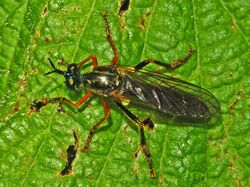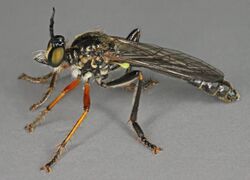Biology:Dioctria rufipes
| Dioctria rufipes | |
|---|---|

| |
| Dioctria rufipes female, dorsal view | |

| |
| Side view | |
| Scientific classification | |
| Domain: | Eukaryota |
| Kingdom: | Animalia |
| Phylum: | Arthropoda |
| Class: | Insecta |
| Order: | Diptera |
| Family: | Asilidae |
| Genus: | Dioctria |
| Species: | D. rufipes
|
| Binomial name | |
| Dioctria rufipes (De Geer, 1776)
| |
| Synonyms[1] | |
| |
Dioctria rufipes, the common red-legged robberfly, is a species of robber fly in the subfamily Dasypogoninae of the family Asilidae.
Distribution
This species can be found in most of Europe (Austria, Belgium, Bulgaria, the Czech Republic, Denmark, Estonia, France, the Netherlands, the former Yugoslavia, Germany, Poland, Romania, Russia, Slovakia, Sweden, Switzerland, Hungary, Great Britain and Italy), in the Near East, and in the eastern Palearctic realm.[2]
Habitat
This species mainly inhabit scrubby grassland, well wooded areas, woodland edge and hedgerows.[3][4][5]
Description
Dioctria rufipes can reach a body length of about 8–15 mm (0.31–0.59 in) and a wings length of 7.5–9 mm (0.30–0.35 in).[5][6] These medium-large robber flies have a black head and hard piercing mouthparts.[4] The antennal tubercle is well-developed above the eyes. The mesothorax is black, lightly pubescent, with inconspicuous longitudinal stripes. The abdomen is slender, dorsally wider towards the back. The front legs are completely orange-red, whereas the hind legs are mainly black.[4] They show a complete stripe of pale, short and soft pubescence (tomentum) on the sides of the thorax (pleura), with an additional ventral stripe above middle coxa.[7][8]
Biology
Adults can be found from May to July–August.[4][6] These insects are predators on other insects. They mainly feed on parasitic wasps,[4] ichneumonids,[5] sawflies, empidid flies and a few small species (Phora, Oscinis, Opius species).[9] The larvae develop as predators in the ground.[3]
Gallery
References
- ↑ Catalogue of life
- ↑ Fauna Europaea
- ↑ 3.0 3.1 Steven Falk Dioctria rufipes (Orange-legged Robberfly)
- ↑ 4.0 4.1 4.2 4.3 4.4 Nature Spot
- ↑ 5.0 5.1 5.2 Gedling Conservation Trust
- ↑ 6.0 6.1 J.K. Lindsey Ecology of Commanster
- ↑ Identification key to the Dioctria-species
- ↑ Fritz Geller-Grimm Provisional key to Central European species of the genus Dioctria Meigen
- ↑ B. M. Hobby - A Study of the Prey of Dioctria rufipes de G. (Diptera, Asilidae) in an Oxford Community - Journal of Animal Ecology - Vol. 1, No. 1 (May, 1932), pp. 77-82
External links
Wikidata ☰ Q10755708 entry
 |


